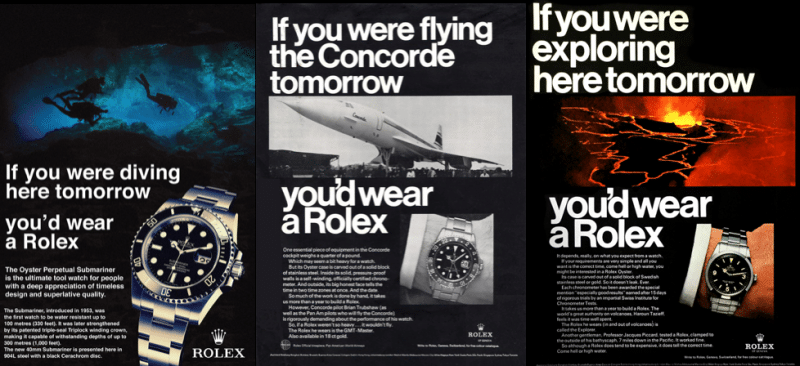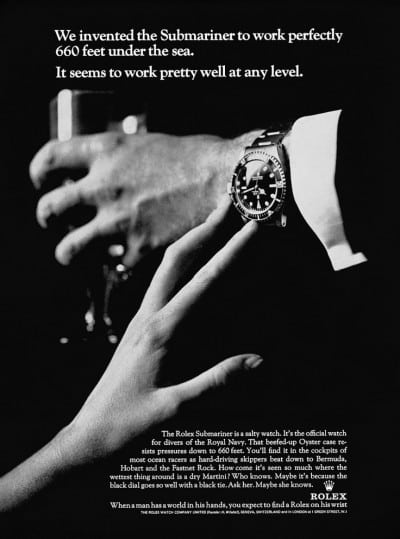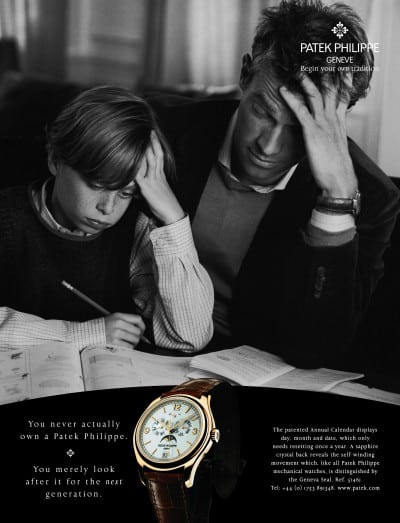
Rolex has just over 30% of the luxury watch market share — with sales greater than the next five biggest players combined.
And, if anything, that underestimates Rolex’s dominance.
For watches costing over $10K, Rolex and Patek Philippe have a combined market share of 70%.
All while Rolex intentionally limits production of its watches!
Ask a non-watch enthusiast to name a luxury brand and Rolex will likely top the list.
They are, without a doubt, the most powerful and influential watch company in the world.
So… it’s natural to ask: why and how that came to be?
Really, it goes back to the founder, Hans Wilsdorf, and his ability to craft a powerful brand identity by choosing what NOT to focus on.
See, Wilsdorf was a massive Anglophile. It’s why he named his second watch brand Tudor.
Also, Wilsdorf personally identified as a merchant and not a horologist or watchmaker.
So his conception of a watch was decidedly Anglo-Saxon, as opposed to continental.
Meaning he saw a wristwatch as a TOOL, not an object d’art.
And if you see a watch as a tool, here’s what you DON’T focus on:
- Decorated movements
- Display case backs (for showing off decorated movements)
- Refined dress watch proportions and thinness
- Grand Complications
- Precious metals (Rolex makes watches in gold and platinum, but it’s not their mainstay)
Horologists or watchmakers would naturally focus on this stuff. But an anglophile merchant like Wilsdorf wouldn’t and indeed didn’t.
And this is a radical departure for a luxury watch, as most of the other established brands obsessively focus on these very qualities, precisely because they see what they create as refined cultural artifacts — like a Rembrandt you can wear on your wrist.
But if you see a watch as a tool, what you DO focus on is:
- Accuracy
- Rugged reliability
- Water Proofing
- The non-fussiness of automatic winding
- Durable, all-metal bracelets instead of fancy leather straps.
- “Professional” watch models aimed at explorers, pilots, and divers
Just think about Rolex’s most iconic watch models — the Datejust, Day-Date, GMT, Submariner, Explorer, Daytona, etc — and you’ll see that they fit this bill perfectly
This is why every model Rolex, even if it’s solid gold and gem-encrusted, is 100 meters water resistant with a screw-down crown, shock-proof, and chronometer-certified.
In contrast, it wasn’t until the 70s that Rolex’s luxury watchmaking counterparts started making steel, water-proof sports watches with bracelets, e.g., A&P’s Royal Oak, Patek’s Nautilus, and Vacheron’s Overseas.
So if you want to know why Rolex became THE luxury watch to own in the U.S. and UK, it’s because Rolex’s conception of a watch perfectly matched the consumer’s conception of what an expensive watch should be.
Go figure that a watch brand built around Anglo-Saxon sensibilities would become a best-seller in Anglo-Saxon countries.
Just understand that a lot of high-end watch snobs consider Rolex as entry-level, precisely because Rolex doesn’t do the things that true luxury buyers want.
If you’re in the market for a highly decorated, grand complication, Rolex ain’t gonna be your bag, baby.
So one lesson here is in Choosing Whom to Loose.
More specifically….
Who are you NOT for? Who do you NOT want as a customer?
You can’t be all things to all people.
But you CAN be the best choice for your target market.
Who are those people, and what makes you their best choice?
If you can answer these questions clearly and powerfully, you are well on your way to having a strong brand.
Focus as intently on what you WON’T do, as what you will.
You will be more easily defined by what you stand against than by what you stand for.
And choosing what you don’t do will put a fine point on that.
For example, when they started, McDonald’s ONLY sold hamburgers and fries in a world where most casual restaurants sold a bit of everything.
Similarly, Dominos only did delivery pizza and Subway only sold sub sandwiches.
In another category, Dell sells every conceivable model of computer and monitor, customizable in almost any way you want for almost any use-case, while Apple sells a handful of models, with limited variations, mostly geared towards “creatives.”
Which of those two is more successful? Which is the bigger brand?
Ensure The Values Embraced by Your Business Resonate with Your Audience
You may be a diamond snob who would never think of buying a created diamond. Or maybe you shudder to think of selling a stone with less than Grade D color and IF clarity.
But do your customers think that way? Do they care about those things the way you do?
Suppose your customers would gladly get a bigger, created stone with an F color and VS2 clarity.
In other words, understand that just like watch snobs are a minority of the luxury watch market, diamond snobs are a minority of the diamond market.
And matching your company values to the market values will allow you to grab a much greater market share than trying to “educate the customer” or chasing after the snobby elite.
As my mentor likes to say, “If you sell to the classes, you will live with the masses. But if you sell to the masses, you will live with the classes.”
 Run Powerful Advertising
Run Powerful Advertising
Not only did Rolex have powerfully resonant brand attributes, it also had powerful advertising campaigns that brilliantly communicating its essential brand appeals.
Indeed, Hans Wilsdorf himself believed that: “only great marketing is needed to make a company successful.”
As an example, take a look at the three Rolex ads in the header of this post.
Or take a gander at the ad to the right.
Everything in these ads is about rugged male accomplishment, as well as the rugged reliability of a Rolex watch.
And these ads are incredibly representative of the kind of campaigns that Rolex ran very aggressively during the heyday of print magazines.
Oh, and remember how Rolex and Patek shared 70% of the market for watches costing over $10K?
Would it surprise you to learn that Patek ALSO ran powerful ads, albeit ones communicating a very different brand value?
 Note both how different the style of watch is from the Rolex as well as the different emotional appeal of the ad from the Rolex ad above.
Note both how different the style of watch is from the Rolex as well as the different emotional appeal of the ad from the Rolex ad above.
So the brands that continuously ran powerful campaigns are the ones that ended up with the lion’s share of their markets. There’s definitely a lesson there.
Dominate Your Market Like Rolex
Now, you may be asking yourself how I know that these specific factors are primarily responsible for Rolex’s success.
And the answer to that lies in the decidedly NON-luxury watch market.
If you look at quartz digital watches, the two most popular brands and model lines are Casio G-Shocks and the Timex Ironman.
Why?
Because they focus on the same masculine brand attributes Rolex did:
— Rugged (and indeed Shockproof) reliability
— Waterproof cases
— Durable rubber straps
— Models aimed specifically at manly endeavors
It’s the same reason denim jeans became the standard uniform of the American male.
Now, I’m not saying YOU should focus on those same attributes.
But I am saying you should focus on those attributes that will resonate strongly with your intended audience.
And that part of communicating those attributes to your customers will involve a sharp delineation of what you stand against and what you won’t do.
If you do that, and you advertise your brand powerfully, you can come to dominate your market like Rolex.
- Getting a Foot in the Door — Of Perception - November 27, 2025
- What Digital Superstars Know About Offline Advertising - November 17, 2025
- Unmistakable: A Tale of Two Boots and Branding Done Right - November 8, 2025
